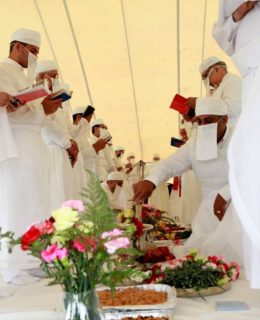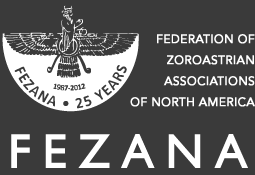The Encyclical of Pope Francis Laudato Si , subtitled On care of our common home resonates with the values of Prophet Zarathushtra, of caring for the environment. Dr Neville Gustad Panthaki has written a special paper ‘Spenta Armaity’ for the Parliament of World’s Religions, Salt Lake City 2015, outlining the Zoroastrian philosophy for preservation of the environment.
This paper can be used as resource material in interfaith dialogues at local levels by individuals when discussing the topic of multifaith approach to addressing the issues of climate change /care of the environment. The author may be contacted at npanthaki@sympatico.ca
In keeping with the Zarathushti Action for Climate Change, Meher Sidhwa, representing FEZANA will be attending the Paris Conference of Nation States (COP) December 2015. The cover image graphic has been designed by Delzin Choksey (Tantra)
Laudato Si! Insight of Spenta Armaity [1]
Article by Neville Gustad Panthaki
In Commemoration of: Oct. 2, 2015 (Fasli Mehrgan: Meher Roj&Mah[2]) / Oct. 4, 2015 (Feast Day: St. Francis of Assisi)
On May 24, 2015, Pope Francis I (formerly Jorge Mario Bergoglio, Archbishop of Buenos Aires) released his second Encyclical (declaration to Catholics) entitled Laudato Si[3]. The chosen title, “Praise Be To You”, is purposeful for the association that it is meant to create and indicative of what follows, as it originates from the Canticle of the Creatures which is a medieval prayer composed by St. Francis of Assisi (1181-1226)[4]. St. Francis, along with St. Catherine of Siena, are the two ‘national’ patrons of Italy, and among the most popularly adored and venerated figures around the globe (St. Catherine is regarded as one, of six, patron saints of Europe)[5]. This is not coincidental, nor is it unrelated to the present discussion to note that the majority of ‘popular’ (admired, adored, endorsed) religious figures irrespective of creed, are those associated with acts of love, welfare and charity, rather than for their stringent adherence to dogma. Global spirituality is composed of figures who expressed their humanity in service, and their praise of divinity via the cultivation and conservation of the treasures of nature.
 St. Francis, the founder of the Franciscan Order[6], is venerated not only as patron of Italians (humans) but of animals (nature) and of lepers (the marginalized/downtrodden/outcaste). This provides insight as to why institutionalized global religions have been unsuccessful in banishing ‘popular’ elements such as the ‘veneration of Saints’, pilgrimage, mela[7], urs[8] gatherings, or ritual re-enactment, despite judgements against their ‘blasphemous nature’ and threats of excommunication against transgressors. One might discern that devoid of the physical expressions (exercise?) of love, encapsulated as a cultural production of affirmation explicitly manifest as a communion with environment and fellowship with humanity, that religion is a reductionist philosophy of pedantic intellectualism whose scope is neither universal nor ‘popular’ (elitist).
St. Francis, the founder of the Franciscan Order[6], is venerated not only as patron of Italians (humans) but of animals (nature) and of lepers (the marginalized/downtrodden/outcaste). This provides insight as to why institutionalized global religions have been unsuccessful in banishing ‘popular’ elements such as the ‘veneration of Saints’, pilgrimage, mela[7], urs[8] gatherings, or ritual re-enactment, despite judgements against their ‘blasphemous nature’ and threats of excommunication against transgressors. One might discern that devoid of the physical expressions (exercise?) of love, encapsulated as a cultural production of affirmation explicitly manifest as a communion with environment and fellowship with humanity, that religion is a reductionist philosophy of pedantic intellectualism whose scope is neither universal nor ‘popular’ (elitist).
Even respected religious reformers such as Zarathustra and Martin Luther, admitted that elements of ‘popular’ belief could not (and in fact, should not) be undone or unfounded with the stroke of a pen or commandment. Both Mazdayasni and Lutheran liturgical practises, by the authority of their very founders, retain many of the celebratory aspects of the systems which preceded them (Perso-Vedic Pantheon, Pre-Reformation Latin Christendom). There was an acute awareness that in ‘reforming’ religion, the aim was to promote social welfare and transformation rather than remove popular engagement between people and their environment by creating a new dogma of oppression. Ritual and belief is only harmful when it restricts the human spirit and denigrates creation. Luther retained certain sacraments, ceremonies, vestments, and architecture of the church[9]. Witness the Khordeh Avesta whose many Yasht (hymns) begin with “Ahura Mazda spake to Zarathustra that….(insert deity or attribute of divinity) is worthy of worship”[10]. Ritual for the sake of popular commitment and expression is essential for the participatory and democratic nature of any fellowship system and is legitimate so long as there is a holistic comprehension of the interdependence between all aspects of creation and their emanation from a single source.
The Pope chose to promulgate Laudato Si on Pentecost Sunday 2015 (May 24), significant because this day is considered the ‘birth of the Church’, when the Holy Spirit descended 50 days after Easter to the Apostles and Mother Mary[11]. Pentecost and Easter are among the only Christian calendar days that fluctuate annually, because they are set according to nature (the ecclesiastic celebration of Easter is determined by the calculation of the spring equinox, which would be Jamshedi-Navroz for Zoroastrians). The symbols of Pentecost are wind, fire and a dove. In Poland houses may be decorated with shrubbery, while in Germany Das Pfingstbaumpflanzen (the planting of trees) and Der Pfingstochse (first leading of adorned oxen to pasture) maintains the emphasis of Pentecost being a ‘green holiday’. In the Baltic region, eggs are decorated in the same manner as at Easter (or for the Navroz table)[12].
Laudato Si should thus, be viewed as a Papal (re-?)affirmation that the Church is firmly rooted (pun intended) in nature, as its protector, whose defense is divinely mandated as a ‘religious duty’ no less than the salvation of the soul. The Pope’s unfinished doctoral dissertation surrounds the work of Romano Guardini (1885-1968) who was the most important Catholic theologian of the 20th Century[13]. The Vatican II reforms, with an emphasis on re-invigorating religion with social purpose through the social activism of the parish priest, can directly be ascribed to Guardini. Reflecting on the essential feature of religion being service, requiring its constant ability to meet contemporary needs by becoming a contemporary institution, Guardini wrote: “The Church is not an institution devised and built at table, but a living reality. She lives along the course of time by transforming Herself, like any living being, yet Her nature remains the same. At Her heart is Christ.”[14] The Pope’s academic background, his choice to take the name ‘Francis’, and his intentional promotion of Laudato Si with reference to Pentecost, creates the unmistakeable image of someone who views environmentalism not as a 21st Century trend, but as the basis of faith-practise.
Laudato Si begins with the following quote from St. Francis of Assisi: “Earth is mother and sister who sustains and governs”[15]. In this and throughout the encyclical we see Papal insight into Spenta Armaity. “We see ourselves as Lords and Masters, entitled to plunder”[16] writes the Pope, but this is ‘devilish’ and equivalent to sin. Pope Francis may not be a Zoroastrian, but perhaps he is a fellow traveller. Spenta Armaity, the Earth, is indeed, our Mother in that she sustains us, as well as our Sister in that we are bound to respect and protect all creation (of which we are part, not Lord over) by pledge of rakhsha bandan (Hindu festival pledging sister-brother love)[17] that is both symbolic but also quite literal for our own survival. Parsis[18] have for too long, cried ‘us too!’ in an attempt to find inclusion with establishments of power, be they political or religious. With Laudato Si, Parsis have a chance to embark on a new era of distinction as equals (leadership, does not belong to the criteria for either spiritual evaluation, nor the success of a faith based community) in a cosmopolitan movement for conservation and preservation which is truly in spirit with Mazdayasni Daena[19], rather than a contortion of it.
Mazdayasni Daena has suffered more than two centuries of unnecessary ‘protestant-izing’. Much of this was the by-product of the Parsi, imperial encounter with the British in India. Parsis worked particularly hard to escape their being classified by the British as ‘Hindu’ (a non-existent descriptor created by imperial administrators to ‘organize’ the unfamiliar diversity which they encountered, into bounded monolithic projections of European categories).[20] Along with ‘tribal’, ‘Hindu’ as a modifier, translated as ‘uncivilized’, ‘effeminate’, and ‘superstitious’, all things that Parsis obviously did not want to be associated with, especially since this would dictate British behaviour and administration towards the community. A proactive campaign of ingratiation toward the occupier was launched which served to create a favourable subaltern political climate for Parsis[21].
The British employed an indirect method (low administrative overhead, and commercial control) of rule which necessitated cooperation from segments of the population while exploiting divide-and-rule methodology, and assessed the Parsis as one such group which could be utilized as a non-threatening instrument of such a policy. The Parsi emphasis on being an Aryan (Iranic) community with little connection to ‘the natives’ other than their displacement among them, simultaneously fit well into the British narrative of White-man’s burden for the export of a civilization-project[22]. Faced with the onslaught of Protestant (especially Reformed Church and Presbyterian) missionaries who chastised the ‘lack of rationality’ in Mazdyasni Daena, Parsis defended themselves by attempting to appear Protestant fellow-travelers if not Christian. A protestant-izing occurred to create “Zoroastrians”, a category which the British could understand and possibly respect; a people with ‘a single book’, ‘a prophet’, ‘a monotheism’ and ‘an iconoclasm’. That is to say, Parsis began to emphasize their identity as similar to ‘people of the Book’, avowedly ‘Western’ in history, culture, belief, and monotheism (ie. ‘not barbaric’ as in ‘other than West’).
Either through the maintenance of this façade, the longevity of a parody over time elevating the concept into dogma, or the neglect of a rich tradition negated wholly as ‘pagan’ and ‘nonessential to Zoroastrianism’, Mazdayasni Daena was disgraced. The Dalai Lama wrote that the best way to learn about one’s own faith, is to study those of others. This self-reflexive exercise initiates a broad understanding of cross-cultural tenets, but also the uniqueness of one’s own spiritual perspectives. Perhaps this is because the unabashed pride (or is that bigotry?) in each of us, seeks to ‘own’ something which we deem important, worthy, great, and unique. We want to have had it first, or at least challenge for co-ownership. Let Laudato Si be the vehicle for a reawakening of sorts for Mazdayasni Daena! In this courageous proclamation by the Pope, let us applaud the undercurrent of Mazdayasni conscious, and then propel ourselves to action with a determination to serve Spenta Armaity as both Mother and Sister!
Our faith is not born out of Enlightenment doctrines and materialist philosophies which provide justification to perverted forms of religion that consider man at the centre of the universe, the measure of all things whose right it is by God to establish dominion over creation. Our spirituality finds affinity in Adivasi[23] and Indigenous beliefs globally which value reciprocity and symbiosis as aspects of worship, asha (order/truth)[24], and indeed moksha (enlightened release) as the ultimate realization of divinity. Indeed, non-Zoroastrian academics such as John Hinnells, Mary Boyce and Martin Haug, having deconstructed Mazdayasni Daena from a theological investigation and (mono)theist lens, reported Zoroastrianism to be ‘cosmological in ethos’ and ecologically conscious[25]. In the Afrin of Dahman (Proclamation/Confession of the Amesha Spenta, as part of the Jashan, blessing, ceremony/celebration)[26], every passage begins with the phrase hamazor bat which translates as “may we be one with…” What follows are the names of Angels, attributes and examples of persons, to each of whom is made a pledge referencing the harmony of life. For example, “may we be one with the water…the sun….the moon…the mountains….the farmer…the souls of the worthy departed…we praise good thoughts, good words, and good deeds, performed here and elsewhere, now and in the past. Thus we glorify and invoke all that is good.”
We are also more Indigenous in our grammar, which does not provide prominence for the masculine. Textual analysis yields the conclusion that the masculine form is actually limiting. For example, of the 6 Amesha Spenta, 3 are female: Spenta Armaity (Holy Devotion, associated with the Earth), Haurvatat (Wholeness, associated with Water), and Ameratat (Immortality, associated with Plants). The remaining 3, are neuter: Asha Vahishta (Best Righteousness, associated with Fire), Vohu Mano (Good Purpose, associated with Animals), and Khshtra Variya (Desirable Dominion, associated with the Sky)[27]. It is quite easy to perceive this as one conceptual framework of Mazdayasni Daena; that Good Thoughts, Words and Deeds, are accomplishment of the ‘good purpose’ (Vohu Mano) of ‘protecting’ (Khshtra Variya), the ‘integrity’ (Haurvatat) of all creation which is ‘essential truth’ (Asha Vahishta) as well as the best form of ‘holy devotion’ (Spenta Armaity) that ensures ‘human legacy’ (Ameratat).
The Magi were considered guardians of ALL life and their spirits. Part of their authority derived from their supposed ‘possession’ of an understanding of holistic relationships, and as overseers rather than over-lords of the natural environment. The word ‘magic’ may be considered to denote the ability of a Mage to ‘master the elements and laws of nature’, representing the action of one who abides by natural law[28]. While one of the Persian imperial symbols is Lion, Verethragna (Behram: remover of obstacles, victory) in the Yasht dedicated to him, is described as having 10 forms: wind, bull, horse, camel, boar, youth, raven, ram, buck, man. In addition to these, Verethragna appears in lore as Bear, one of the most ‘popular’ incarnations and in stark contrast to Lion (which is absent from the list). While Lion dominates the Earth standing atop it, Bear is part of the Earth hibernating within it, receiving strength from it, being ‘re-born’ each spring (Navroz)[29]. Lion (not Lion-ess) is male, while Bear’s symbolic strength within all Indigenous cultures who utilize this motif is decisively female: birthing, nurturing, protecting, Earth, guardian, teacher, wisdom, food, medicine. The latter two criteria invoke another illustration of ‘truth’ regarding human interdependence and Earth guardianship, because a proper respect and understanding of soil, seed and growth, is essential for both sustenance and health. Fundamentally, cooking and medicine (eg. Ayurveda[30]) derive from a ‘proper’ knowledge and respect of the source and combinations (recipe) of earth-ingredients.
Our Gambhars[31] are seasonal worship of nature in praise of Her gift. Espandgan (Aspandard Roj&Mah; Spenta Armaity) is a ‘Persian day of Women and Earth Day’[32]. On occasions when the name of the day and month coincide on the Zoroastrian calendar, it is routine for Zoroastrians to conduct that day’s worship/prayer before an element of nature. For example on Abangan (Ava Roj&Mah; Water), Zoroastrians will pray before bodies of water such as streams, lakes, seas and the ocean. It is notable that Greek historians and commentators such as Herodotus (430BCE) wrote many passages relating to ‘open air’ Mazdayasni worship. Herodotus wrote that it was considered ignorance to worship in an enclosed space, as if limited and segregated from nature. Archeological sites throughout the former Persian Empire have uncovered many open-air altars, many of them atop mountains or in ‘scenic’ valley sites[33]. One has only to think of the ‘sacred geography’ associated with global Indigenous sites of worship, to elicit the understanding that there is no grander or appropriate temple than nature, and that therefore, serenity and awe were the criteria for the location of altars.
Within the daily liturgy of Mazdayasni, one finds the Char Dishano Nameskar which is a ‘Prayer to the 4 Directions’. Although there are many interpretations of this ritual and its accompanying verses, in which the worshiper turns from facing south to east to west to north, it seems indisputable that geographic space (the four directions) is being invoked and praised. Likewise, in the Afringan ceremony of the Jashan, the priest will use tongs (chipyo) to touch various elements lain before him (representing connection to and blessing from the 7 creations, Amesha Spenta) and then use the tongs to perform a marking gesture toward each of the four directions, and repeat this gesture to mark the four median points (eg. North-East, SE, SW, NW)[34]. Regarding the latter, this indicates awareness of liminality, the transmission across categories (no absolutes of borders, categories, or planes of existence).
A further example of our equal, rather than exalted positionality over the rest of creation, occurs in the Mazdayasni understanding and rituals surrounding death. It is understood that the fravashi[35] (spirit) departs the body, and so there can be no remaining attachment to corporal remains in the physical or emotional sense. Grief is not allowed (it is in fact considered ‘sin’) to ‘pollute’ living creation through the process of the disposal of corporal remains. Hence there is no concept of ‘the dignity of the body after death’ by way of its preservation or entombment. Dakhma (‘Towers of Silence’)[36] were constructed in ancient Persia for the purpose of disposing of the dead, and the Parsis of India still maintain a few. The Dakhma is an open-air elevated circular stone construction with a labyrinth type floor. The deceased is placed in the Dakhma on a platform (altar), and carrion birds (vultures) are allowed to ‘clean’ the bones of flesh. Thereafter, the sun bleached bones collect (fall) in the Dakhma interior (the labyrinth floor). This method of corporal disposal was conceived as preserving and respecting creation, not polluting (or preventing the over polluting) of the elements of earth, water, fire, and air. Far from considered ‘evil’, carrion birds were assumed to be necessary purifiers who removed ‘sin’ (some may go so far as to typify them as ‘holy’ or ‘blessed/dutiful creatures’).
Let us pledge this Fasli Mehrgan , which celebrates the harvest of nature under the patronage of Mithra (love, friendship, contracts), to curtail destructive waste and unbridled ‘progress’ with shameless disregard of the ecosystem, Spenta Armaity, our common home which we share with all creation as equals. Our faith is based on free-will; we can embolden Ahura Mazda by preserving creation, or else become participants in our own destruction, ‘the evil which befalls us’ of our own doing. Having lost 80% of our liturgy and historical record through calamities that befell our people[37], let us now, not lose our dignity, faith and salvation through willful neglect and greed.
The Feast Day of St. Francis of Assisi and Mehrgan coincide on the calendar and so should global efforts at Earth stewardship. Let Zoroastrians, having long been chastised as ‘fire worshipers’, take ownership of a new moniker, that of ‘nature worshipers’. This would be, at the very least, a more accurate description of Mazdayasni faith, and an association to be proud of!
Neville Gustad Panthaki has pursued two Doctorates (Ph.D) in Eurasian History and International Diplomacy (York University, Toronto) and Social Justice Education (Ontario Institute of Studies in Education at the University of Toronto)
THIS ARTICLE CAN BE ACCESSED AT www.fezana.org
[1] One of the 6 Amesha Spenta (Arch-Angel or Divine Attributes) of Mazdayasni Daena (also known as Zoroastrianism). http://www.accessnewage.com/articles/mystic/armait.htm Accessed September 25, 2015.
[2] Although there are different versions of the Persian calendar, its components are 12 months with 30 days each. Each day is attributed/named to an Angel or attribute of Divinity, as is each month. When (in this case, the Fasli version of the calendar) the name of the day (Roj) and month (Mah) coincide, festivals are held in commemoration similar to the Catholic notion of a ‘Feast Day for the Patron of…”. http://www.persiandna.com/calendar.htm Accessed September 27, 2015.
[3] http://w2.vatican.va/content/francesco/en/encyclicals/documents/papa-francesco_20150524_enciclica-laudato-si.html Accessed September 27, 2015.
[4] http://www.sacred-texts.com/chr/wosf/wosf22.htm Accessed September 27, 2015.
[5] http://saintcatherineofsiena.ca/Our_Patron_Saint.html Accessed September 27, 2015.
[6] http://www.catholic.org/encyclopedia/view.php?id=4838 Accessed September 27, 2015.
[7] A gathering, in this sense, religious rather than commercial. For example, the Hindu Kumbh Mela is the largest in the world. http://www.britannica.com/topic/Kumbh-Mela Accessed September 27, 2015.
[8] The death anniversary of a Sufi pir, commemorated at a shrine. http://www.exoticindiaart.com/book/details/dargah-of-nizamuddin-auliya-IDK083/ Accessed September 27, 2015.
[9] A study of Reformation history will indicate that many were displeased with what was perceived as a ‘limited reform’ by Luther. This is best exemplified by a contrast between Luther and Calvin, regarding ‘how to reform Christianity’ and ‘what was essential to faith and practise’. http://www.reformedreflections.ca/faith-and-life/martin-luther-john-calvin.html and also http://sbcvoices.com/john-calvin-vs-martin-luther-similarities-and-differences/ September 27, 2015.
[10] For example, the Meher (Mihr) Yasht http://www.avesta.org/ka/yt10sbe.htm Accessed September 27, 2015.
[11] http://www.newadvent.org/cathen/15614b.htm Accessed September 27, 2015.
[12] http://www.newbyzantines.net/byzcathculture/pentecost.html and http://www.examiner.com/article/seeing-green-on-pentecost-sunday and http://www.godrej.com/godrej/GodrejandBoyce/pdf/2002/marapr/jamshedi.htm and http://www.cais-soas.com/CAIS/Celebrations/haftsin.htm Accessed September 27, 2015.
[13] http://www.crisismagazine.com/2014/romano-guardini-father-of-the-new-evangelization Accessed September 27, 2015.
[14] Of importance and note, is that ‘Her’ is used, rather than ‘He’ or ‘it’. Ibid.
[15] http://w2.vatican.va/content/francesco/en/encyclicals/documents/papa-francesco_20150524_enciclica-laudato-si.html Accessed September 27, 2015.
[16] Ibid.
[17] http://hinduism.about.com/od/rakhi/a/rakshabandhan.htm Accessed September 27, 2015
[18] Mazdayasni (known as, Zoroastrian) religious group of Persia, settled in India. http://www.britannica.com/topic/Parsi Accessed September 27, 2015.
[19] Literally “the faith of (Ahura) Mazda” or the “faith of those professing belief in Mazda”. It is ‘equivalent’ to Zoroastrianism when identifying the members of this faith group. However the term Zoroastrianism is indicative of a label used to describe the Mazdayasni faith group. The relevance of this follows in the next paragraph.
[20] The works of Jaffrelot, Addas, Chatterjee, Skaria, shed light on the cultural imperialism and transformation of identities which occurred during British imperialism in South Asia.
[21] It resulted in a favoured status and commercial growth, so that Parsis were among the first Indian nationals to set up the first financial institutions and industrial corporations.
[22] Justification for rule found apologists among the literary figures and anthropologists of the day. A cursory glance at figures such as Wellington or Rudyard Kipling or Herbert Spencer, provide a few examples.
[23] Term for ‘aboriginal peoples’ (plural) of several ethnicities, ‘tribes’ and clans, geographically encompassing India (and South Asia as defined by the United Nations, from Iran to Myanmar, and Tibet to Sri Lanka).
[24] http://www.iranicaonline.org/articles/asa-means-truth-in-avestan Accessed September 27, 2015.
[25] In addition, see Homi Dhalla’s article http://homidhalla.com/downloads/zoroastrian_ecology_1.pdf Accessed September 27, 2015.
[26] http://www.avesta.org/afrin/ag.htm Accessed September 27, 2015.
[27] http://www.avesta.org/angels.html Accessed September 27, 2015.
[28] http://www.heritageinstitute.com/zoroastrianism/priests/index.htm and https://en.wikipedia.org/wiki/Magi Accessed September 27, 2015.
[29] http://www.avesta.org/ka/yt14sbe.htm and https://en.wikipedia.org/wiki/Verethragna Accessed September 27, 2015.
[30] Naturopathic and indigenous medicine tradition of India. http://altmedicine.about.com/cs/2/a/AyurvedaDef.htm Accessed September 27, 2015.
[31] There are 6 of these. http://www.heritageinstitute.com/zoroastrianism/gahambar/ Accessed September 27, 2015.
[32] http://worldculturalheritagevoices.org/espandgan-womens-day-in-ancient-persia/ Accessed September 27, 2015.
[33] http://www.heritageinstitute.com/zoroastrianism/temples/index.htm Accessed September 27, 2015.
[34] http://www.avesta.org/afrin/asb.htm and http://www.heritageinstitute.com/zoroastrianism/ceremonies/liturgy.htm Accessed September 27, 2015.
[35] http://www.britannica.com/topic/fravashi Accessed September 27, 2015.
[36] http://www.heritageinstitute.com/zoroastrianism/death/page3.htm Accessed September 27, 2015.
[37] This occurred via the several invasions and displacements in Persian history (eg. Alexander, Arabs, Mongols) https://en.wikipedia.org/wiki/History_of_Iran Accessed September 27, 2015.





